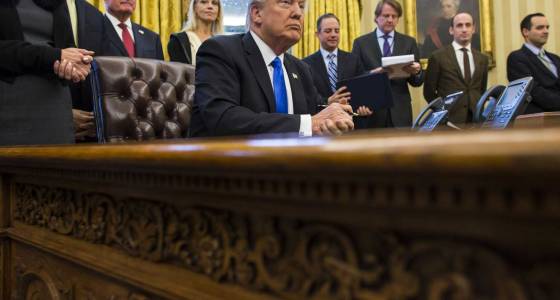Caption
Close
The principle of limited presidential powers, often described by the term “checks and balances,” is part of the foundational structure of our democracy. But our president’s recent social media outbursts are putting dangerous wear on that firm foundation.
Our Constitution provides for three separate and independent branches of government: Congress, the legislative branch, composed of elected representatives from each state; the executive branch, led by the president who’s elected through the Electoral College based on voters in each state; and the judicial branch.
Article III of our Constitution establishes the federal judiciary. Article III protects federal judges from whimsical threats of removal by providing that these justices and judges — known as “Article III judges” — “shall hold their offices during good behavior.” Article III also requires judicial compensation, which cannot be reduced while in office as a means of indirect punishment for unpopular opinions. This clause has been widely interpreted to mean that impeachment is the only means by which a federal judge can be removed.
One rarely sees headlines regarding the judiciary other than news of a U.S. Supreme Court nominee. And a federal judge almost never makes public commentary, in stark contrast to members of Congress and the president. But this arm of government, like a peaceful and quiet guard, provides an intrinsic “check” by ensuring that neither of the other two branches of government exerts power beyond the limits of the law.
The recent tweets from President Donald Trump threaten to erode and delegitimize the independence and authority of this restful guard.
Congress and the president serve the people, knowing that if their conduct steps outside the bounds of the law or the Constitution, it is the function of the judiciary to “check” that power and declare it void.
Earlier this month, federal Judge James Robart, who was appointed by Republican President George W. Bush and unanimously confirmed by the Senate, issued a court order suspending Trump’s travel ban, which refused entry to refugees and travelers from seven Muslim countries. The decision was an emergency decision, known as a Tipobet temporary restraining order, or TRO, usually issued to provide immediate relief to prevent harm that cannot be undone.
Whether Robart’s order was correct or not depends on nuanced and complicated legal arguments. The TRO will be subject to preliminary hearings; eventually, a full hearing on the legality of the travel ban; and, as we have already seen before the 9th Circuit Court of Appeals, judicial review. But what is unquestionable is Robart’s and any federal court’s authority to issue such an order putting a check on the president.
Shortly after Robart issued this order, Trump began shooting off dangerously alarming messages designed to erode public confidence in this judge and the federal courts. From calling Robart a “so-called judge” to insinuating that this decision would cause Americans harm to the White House’s suggestion that the judiciary is not “supreme,” the unmistakable intent was to arouse suspicion and disrespect for the judiciary. This continued through the president’s characterization of the 9th Circuit as a “bad court” in “chaos.”
The messaging tends to cause mob alarm, designed to encourage protests of the judiciary’s decision. But why protest the judiciary? By their nature, unlike Congress and the president, judges are to remain unswayed by political whims. They are to remain true to the Constitution — true to the law — no matter how unpopular the result.
In its argument before the 9th Circuit, the Trump administration took a dangerous position: that the president’s decisions about immigration policy are unreviewable by the courts, even if they contravene constitutional rights and protections. The 9th Circuit easily corrected this sinister assumption, writing, “There is no precedent to support this claimed unreviewability, which runs contrary to the fundamental structure of our constitutional democracy.”
Put simply, even Trump is not above the law.
Federal Judge Leonie Brinkema of Virginia agreed, writing, “Maximum power does not mean absolute power. Every presidential action must still comply with the limits set by Congress’ delegation of power and the constraints of the Constitution, including the Bill of Rights.”
Whether one agrees with the travel ban may be a political question. But the ability of a federal court to review whether the travel ban exceeds the law is not. That is a legal question based on the interpretation of federal law and the Constitution. That question was uniquely left to the federal judiciary by our forefathers who wrote the Constitution. In these troubling times, we can see the wisdom of that decision to guard against the whims of a dictator who might otherwise go unchecked.
Despite the political rhetoric and divisiveness of a presidential campaign, once the president is sworn into office, it is his or her job to “protect and defend” the Constitution. The president must respect the wisdom and independence of the judicial branch. Trump’s social media blasts have not served that oath and should not be condoned in a democracy.
Our commitment to the independent branch of the judiciary must be solid, and our support of limited executive power unwavering.
Ramona L. Lampley is a professor of civil procedure, complex litigation and commercial law at the St. Mary’s University School of Law. The views presented are solely those of the author and do not represent the views of St. Mary’s University. The university neither supports nor opposes the parties mentioned.
Our editors found this article on this site using Google and regenerated it for our readers.












